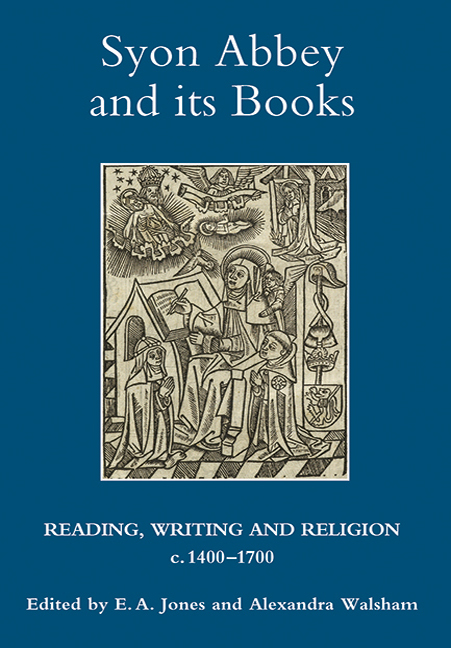Book contents
- Frontmatter
- Contents
- List of Illustrations
- Acknowledgments
- Notes on Contributors
- List of Abbreviations
- Syon Abbey: An Outline Chronology
- Introduction: Syon Abbey and its Books: Origins, Influences and Transitions
- I Brothers and Sisters
- II Syon Abbey and the Book Trade
- III The Bridgettines in Exile
- 5 Continuity and Isolation: The Bridgettines of Syon in the Sixteenth and Seventeenth Centuries
- 6 Books and Reading at Syon Abbey, Lisbon, in the Seventeenth Century
- IV History and Memory
- Appendix Syon Abbey's Books at the University of Exeter
- Index
- Miscellaneous Endmatter
5 - Continuity and Isolation: The Bridgettines of Syon in the Sixteenth and Seventeenth Centuries
from III - The Bridgettines in Exile
Published online by Cambridge University Press: 09 May 2017
- Frontmatter
- Contents
- List of Illustrations
- Acknowledgments
- Notes on Contributors
- List of Abbreviations
- Syon Abbey: An Outline Chronology
- Introduction: Syon Abbey and its Books: Origins, Influences and Transitions
- I Brothers and Sisters
- II Syon Abbey and the Book Trade
- III The Bridgettines in Exile
- 5 Continuity and Isolation: The Bridgettines of Syon in the Sixteenth and Seventeenth Centuries
- 6 Books and Reading at Syon Abbey, Lisbon, in the Seventeenth Century
- IV History and Memory
- Appendix Syon Abbey's Books at the University of Exeter
- Index
- Miscellaneous Endmatter
Summary
We know, feel and have experienced for more than seventy years the full hardships of this our exile; of which our many afflictions, sorrows, and tears are true witnesses and, with our injuries, sufferings and dangers on land and at seas, true testimony of how much we have had to suffer; finally the aching loss of our native land, families and mother tongue, as well as our extreme poverty in foreign lands and kingdoms, declare and make evident the burdens and great difficulties we have experienced and carried on our shoulders.
‘The Petition to her Royal Highness the Princess of Wales whom God Preserve’, in de Hamel, Syon Abbey, p. 25The heartfelt words of Prioress Barbara Wiseman and the Bridgettine sisters in Lisbon to the Spanish Infanta might have been written by any of the exiled English nuns during the seventeenth century. As members of a religious minority which was not permitted officially to practise its faith, hundreds of women left their homeland to join expatriate religious communities abroad. The exodus began in the aftermath of Henry VIII's dissolution of the monasteries when groups of Bridgettines, Dominicans, Poor Clares and possibly nuns of other orders travelled abroad to continue their pious vocation in continental cloisters. Likewise, individuals determined to maintain their vows settled in foreign houses. The numbers of English Catholics desiring a monastic life for themselves or their female kin were so high that by the late sixteenth century the first post-Reformation abbey was established for Benedictines in Brussels. An English Poor Clare convent was founded at St Omer in 1608, and in 1609 the English women resident in the Flemish cloister of Augustinian canonesses in Louvain departed to form their own community. By the end of the seventeenth century, there were twenty-two contemplative English convents which had survived the vicissitudes of exile and poverty described by the Bridgettine nuns eighty years earlier. Twenty-one were located within a relatively small part of north-western Europe, in the Low Countries and in France, while the Bridgettines resided to the south in Lisbon.
The history of the English Bridgettines is thus closely connected with that of the other expatriate cloisters, yet it is also distinct. Unlike the other post-Reformation religious houses which had tenuous links with the pre-dissolution monastic orders, the Bridgettine nuns could claim direct continuity with pre-Reformation Syon Abbey in Isleworth.
- Type
- Chapter
- Information
- Syon Abbey and its BooksReading, Writing and Religion, c.1400-1700, pp. 155 - 176Publisher: Boydell & BrewerPrint publication year: 2010



